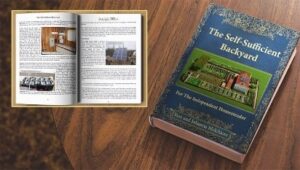Introduction:
Permaculture is a design system for creating sustainable human settlements and agricultural systems. It works with nature rather than against it, utilizing efficient strategies to reduce waste while providing food, energy, shelter and other resources needed in order to sustain life. Permaculture principle number one: Care for the Earth is the first principal. What exactly does this mean? How can we best act on this principle in order to create a healthier, more sustainable future for our planet?
Permaculture Principle Number One: Care for the Earth

Care for the Earth, permaculture principal number one is about recognizing and honoring the interdependent relationship between humans and the natural environment. It involves understanding and respecting the intricate balance of nature’s systems and acting accordingly. To truly care for the Earth, we need to become conscious of how our actions affect the environment and make changes when necessary. This includes minimizing waste and energy consumption; promoting renewable sources of energy like solar and wind power; preserving natural ecosystems for wildlife, plants, and soil health; and supporting sustainable agriculture practices such as permaculture gardening.
Cancer Alley
Lest you think I am channeling Greta Thunberg, I enjoy being cool enough in the summer and warm enough in the winter. I enjoy being able to afford to buy food. What I don’t like is what big business and big government have done in the name of making a dollar. Between Baton Rouge and New Orleans, along the Mississippi is a corridor called cancer alley. The area with a high concentration of petrochemical plants is known as “Cancer Alley” because its residents have a greater risk of developing cancer. The pollution released by these plants can lead to respiratory issues, cancer, and reproductive difficulties, among other serious health problems. The government and the companies have known about this issue for decades. Very little has been done. We need to do a better job safely disposing of waste but that cost more so in the name of the bottom line we are polluting our world and don’t think people like the CEOs of these companies or our government officials are worried. They know where this stuff is dumped and live accordingly. But what happens when there is no place safe left?
Instead of caring for the Earth, we are seeing a rapid degradation of the environment due to human activities. Whatever you think about global warming and climate change, by some estimates we are losing 150 species to extinction daily. Loss of biodiversity is not only detrimental to wildlife populations, but can also have serious effects on our own health, as it affects the availability of clean air, water, food, and medicine. Additionally, pollution of all kinds releases toxins into the environment that can accumulate in our bodies. Have you heard of the dirty dozen? Not the movies, the list of fruits and vegetables that are so full of pesticides and other pollutions it recommended you buy organic. Look it up it may surprise you.
To truly care for the Earth, we must take action to reduce our environmental impact. Practicing permaculture in our yards, our parks, our green areas can help. We can also advocate for better policies to limit pollution and preserve land and we should do what we can to do that but it’s an uphill fight as our government and big business care much more about their bottom line. Individually we can help by reducing our resource consumption through recycling, composting, and reusing materials; supporting local farmers who practice sustainable agriculture; investing in renewable energy sources; and educating ourselves about the importance of protecting our planet.
What Can You Do
It may be true that only collective action can ensure a healthy future for the world, but if the collective is not made up of strong individuals with regard for the sanctity of individual rights the results may not be what we hope. Part of the reason we are where we are is because big government and big corporations don’t care about the individual person or community. We must individually take responsibility for our actions and strive to make conscious choices that promote sustainability, resilience, and respect for all life on Earth. Start with your yard. If you have a perfect expanse of grass, you are probably not doing your part. When you fix that, move on to your neighborhood and then your town. Start composting and do your part to decrease the landfills. Grow some of your food and buy local to decrease the need for transporting food 100’s if not 1000’s of miles. Set up a beehive if you have room and are not allergic.
Conserving and restoring ecosystem, protecting and enhancing wildlife habitats and their populations, improving water and air quality, increasing soil fertility, promoting pollinator health, creating carbon sinks for greenhouse gases, and sustaining healthy agroecosystems for wildlife, plants, and soil health are all fine ideas. Fine ideas often remain just that. Individuals understanding the possible cost and who are committed to making life better for their children don’t generally stay with just fine ideas.
Conclusion
Each of us has the power to make a positive difference for our planet and its inhabitants. We can start by being conscious of our actions, learning about sustainable practices, supporting organizations that promote conservation efforts, and advocating for equality. If we have to dump pollution let’s make sure the 1% get a little of that love as well not just the little people they don’t believe matter regardless of what they may say. I’m guessing that might cause rapid progress to be made regarding better practices. We must remember that we are all part of a larger interconnected web of life, and work together to create a healthier future for all.
This is what permaculture principle one “Caring for the Earth” means: my grandchildren and yours won’t be left with nothing but the dirty dozens to eat.
Thank you for taking the time to read this article. If you would like to read more check out How to start a Permaculture Garden.
Also my next article on Permaculture Principle two is here.
Reference:
1. Mollison, B., Slay, D. (2014). Introduction to Permaculture: 2nd Edition. The permaculture research institute of Australia Incorporated.
2. Soil Association (2020). Soil Organic Matter https://acsess.onlinelibrary.wiley.com/doi/10.2136/sssaj2013.06.0214nafsc
3. Permaculture News https://www.permaculturenews.org/2023/04/01/the-philosophical-basis-of-land-nurturing/
6. Center for Food Safety (2019). What is Permaculture? Available at https://www.centerforfoodsafety.org/issues/906/agroecology-and-sustainable-agriculture/what-is-permaculture

